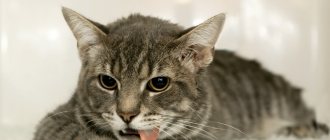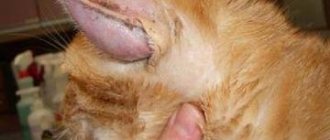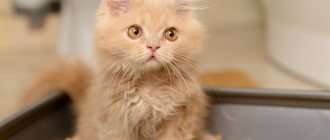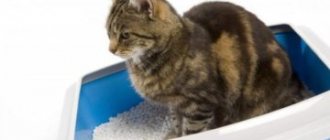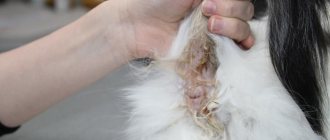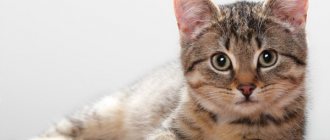Experienced breeders, as well as owners of older cats, may be sadly familiar with the name of the disease “pyometra,” or, in other words, acute purulent endometritis. Why are domestic cats so often predisposed to purulent inflammation of the uterus?
The fact is that cats, unlike most other mammals, can ovulate (ovulation is the process of the release of an egg from an ovarian follicle) only during normal sexual intercourse (or its imitation) due to mechanical irritation of the mucous membrane of the genital organs. This phenomenon is called induced ovulation. If an uncastrated cat lives alone at home and is unable to fulfill her sexual desires, the lack of ovulation does not allow the cat's sexual cycle to successfully complete.
Hormonal stimulation, caused by the length of daylight hours and the functioning of the ovarian germ cells, forces the sexual cycle to restart again and again. Thus, uncastrated domestic cats exhibit undulating heat, taking a break of only a few days.
In some animals, the heat period is manifested by slightly more affectionate behavior and wallowing on the floor, while in some (especially typical for short-haired breeds, such as Siamese), heat can be accompanied by violent behavior, loud screams and disobedience. Sometimes cats fill the house with their melodious songs almost around the clock, which, of course, causes some inconvenience to the owners.
In addition to everyday discomfort, the state of incessant estrus is fraught with the development of pathological processes in the reproductive system. Thus, such “bombardment” of sex hormones over several years makes the endometrial layer of the uterus more susceptible to the growth and development of pathogenic microflora. Microorganisms can enter the loose, “tired” endometrium with increased secretion of glands through an ascending route - if the cat has cystitis, urethritis, or even an asymptomatic infection.
Unfortunately, quite often we note that inexperienced cat owners can contribute to the development of endometritis by giving their pet hormonally unbalanced drugs to block estrus (Contrasex, Stopsex, etc.) This is how purulent inflammation of the endometrium begins, which, when worsened, can lead to sad the known condition of pyometra (purulent uterus).
Khomutinnik Ekaterina Igorevna Chief veterinarian. Candidate of Veterinary Sciences. Specialization: soft tissue surgery, abdominal and thoracic surgery, endosurgery.
Pyometra is a disease in which a significant amount of purulent mass accumulates in the cavity of the uterine horns. The wall of the uterine horns itself becomes very thick, swollen, inflamed, or, on the contrary, in certain places it becomes thinner to the state of a film, thereby exposing the body to the danger of rupture of the organ and the outpouring of pus directly into the abdominal cavity. Such extensive internal inflammation causes physical discomfort, pain, and fever in the animal. Microorganisms, tissue breakdown products, toxins are carried through the blood and lymph throughout the body, causing both local and generalized septic processes (blood poisoning).
Causes of inflammation of the uterus
Today, veterinarians have found that the disease is mainly caused by the following reasons::
- hormonal imbalances, after which endometritis was not fully treated;
- inflammatory pathologies of the urinary system that have not been properly and completely treated;
- giving the animal hormonal drugs to prevent estrus and pregnancy;
- violation of sanitary rules at the time of mating of an animal, when a cat and a cat are brought together that has not been examined for various bacterial infections of the reproductive system;
- unsanitary conditions in the place for childbirth, due to which dirt and pathogenic bacteria are introduced into the birth canal and uterine cavity;
- the remains of the placenta that did not come out after the birth of the kittens - suppuration in such a situation develops within a few days after lambing;
- pathologies in the structure of the reproductive system, in which an open cervix provides bacteria with free access to the inside of the organ.
© shutterstock
Stress, during which an animal experiences a sharp general decrease in immunity, deserves special attention. If lambing occurs during this period, or the cat is in a state of heat, then the uterus is defenseless against pathogens, which rapidly develop against the background of hormonal changes in the body.
In cats that have not given birth to kittens, pathogens penetrate into the organ in small quantities and the uterus contains them after the first heat. They are restrained by local immunity, when it fails against the background of a hormonal imbalance, they begin to develop and cause inflammation with subsequent suppuration.
Prevention of pyometra
It must be remembered that even successfully carried out therapeutic treatment of pyometra with preservation of the uterus does not protect against recurrent endometritis in one of the subsequent sexual cycles!
One hundred percent prevention of the development of purulent endometritis in animals is exclusively timely castration! Only the absence of the gonads (ovaries) makes it impossible for the development of specific pathological processes in the endometrium of the uterus.
Early castration (oophorectomy before the first heat) prevents not only diseases of the reproductive organs, but also breast tumors, since they are hormone-dependent target organs. Mammary gland carcinoma is a very common pathology in cats over ten years of age, but the oncological process in this case can also be avoided by bringing the cat for surgery to remove the ovaries before the first heat (at about 7-8 months). Take care of your pet's health in advance!
Symptoms
The disease has 3 forms. The greatest danger of them is the hidden one, due to which the animal’s condition deteriorates very slowly, and symptoms appear only at the last moment, when the uterus is close to rupture, and it is almost impossible to help the pet.
Another form of inflammation, in which the cat’s uterus has an open cervix, is not so dangerous, since it cannot lead to the death of the animal in 1-2 days. However, this does not mean that the cat can do without therapy. If the animal's condition is left unattended, its death will occur within 1-2 weeks. Only sometimes there are cases when a very strong cat can live up to 3 weeks. With this pathology, the animal experiences the following symptoms of uterine inflammation :
- discharge of pus from the genital fissure (vagina);
- the cat licks the external genital area excessively;
- dark brownish spots where the cat sleeps;
- complete loss of appetite;
- elevated temperature;
- The cat drinks a large amount of liquid.
Every day the pet's condition worsens. The volume of purulent discharge increases, the uterus constantly pours out pus, and the cat no longer has time to wash it off, which makes it noticeable not only on the bedding, but also on the fur around the genital opening.
© shutterstock
Another form of the disease, which occurs when the cervix is closed, is rapid, and if the cat does not receive urgent treatment, then it dies after 2, maximum 3 days because the uterine lining ruptures. This occurs because the uterus is overfilled, since due to its closed cervix, pus does not flow out. When a rupture occurs, its contents spill into the abdominal cavity, causing peritonitis. Symptoms of the disease are :
- drops of pus on the genitals or their complete absence while simultaneously observing other symptoms that the uterus is inflamed;
- a rapid increase in the volume of the abdomen - it suddenly becomes tight and painful, as the uterus is filled with pus. The increase disappears before our eyes and sometimes in just a few hours;
- rapid rise in temperature;
- complete refusal to eat;
- drinking particularly large amounts of liquid;
- intense diarrhea - does not always occur;
- frequent, scanty urination - due to the fact that the uterus is very enlarged, even a small amount of urine causes a sharp increase in pain and leads to the fact that the cat strives to immediately empty the organ;
- severe apathy;
- very heavy breathing;
- the cat completely loses its reaction to any external stimuli.
Usually the disease begins to manifest itself 1-2 months after inflammation begins to develop. During this time, bacteria manage to multiply in sufficient quantities in the uterine cavity, where favorable conditions are constantly present for them, if local immunity does not work.
The uterus can also become inflamed while the cat is pregnant. In such a situation, it is impossible to save the kittens, and they die. With timely treatment, the cat itself can survive the inflammation, but since the uterus will be surgically removed, the female will lose the ability to give birth to kittens.
Uterine pyometra in dogs, cats: treatment, antibiotics, surgery, removal
Uterine pyometra in dogs
The treatment for uterine suppuration can be therapeutic or surgical. Although the latter seems more drastic, sometimes there is no other way to solve the problem. Of course, the cat will lose the opportunity to have offspring in the future, but will live a long and healthy life.
Worth knowing: To carry out therapeutic treatment, the cat is prescribed medications that help remove pus from the uterine cavity. This method is suitable for the early stages of the disease, but later it will be useless. Treatment is prescribed only by a veterinarian!
As mentioned above, only those cats that have been sterilized are not at risk of contracting pyometra. But, if the owner does not want to decide on this procedure and feels the strength to maintain the cat’s health in normal conditions, several rules must be followed:
- Visit your pet's veterinarian regularly. This is necessary so that he can not only assess the risk of the animal’s pyometra disease, but also assess the general condition of its body.
- Taking hormonal medications should also be coordinated with him in order to avoid possible problems and mistakes.
- It is necessary to check the cats with which the cat mates.
In case of any changes in the behavior and health of the animal, you should definitely contact a specialist.
Diagnosis of uterine inflammation
If inflammation is suspected, the cat should undergo an ultrasound. The examination determines how much the uterus has changed in size and determines the presence of purulent contents in it. It is also often discovered that the uterus has cysts and local thickenings on the walls.
© shutterstock
A blood test is also performed to determine the cat's general condition and confirm that the uterus is experiencing acute inflammation . Changes in its composition during pyometra are very characteristic and clear.
Where does purulent discharge come from?
Purulent vaginal discharge is very diverse, so there may be several reasons.
Most of them are an immediate danger to the cat's health. However, there are also more passive prerequisites that can be taken more calmly. It is important to determine the nature of the clots, understand whether they are purulent, and only then take action.
Safe discharge
One of the standard types of discharge in cats is estrus. This can happen several times a year, according to the cycle. There are no purulent formations, so the owner can be absolutely calm about the health of his pet. This usually lasts no more than a few days and is accompanied by an increase in the cat's activity. Therefore, even a layman can classify such processes. It is worth understanding that with any vaginal discharge you need to remain vigilant.
© shutterstock
Clots during cat pregnancy and childbirth deserve special attention. Here, both translucent mucous clots and greenish liquid are possible.
Of course, we are not talking about bloody and purulent options. But certain types of formations are quite acceptable at different stages of pregnancy. Therefore, they should not be feared either.
Dangerous secretions
And here is where there is cause for serious concern. There are several options that may be associated with more dangerous discharge. Among them:
- infections;
- inflammation;
- oncological diseases and others.
Particular attention should be paid to a pregnant cat. During complications during childbirth, a situation periodically occurs when the placenta remains partially inside. This may be accompanied by purulent-bloody vaginal discharge. This indicates the process of decomposition in the cat's body. Such purulent formations can be removed surgically.
Infectious diseases of the genitals. A reddish tint to purulent discharge may indicate pathogenic processes in the bladder or uterus. These formations often do not have a specific odor, but are characterized by a peculiar thick consistency. If such clots are detected, you should immediately consult a doctor.
Oncological diseases are also associated with purulent processes. Since cancer cells affect all systems of the body, to one degree or another, such diseases may cause purulent discharge from the loop. They will have a peculiar smell, which will indicate destructive processes inside the cat’s body.
© shutterstock
Inflammation can cause mucous formations. During this period, the cat may become restless, begin to lick itself, and show aggression.
You may also notice some painful sensations when trying to relieve a minor need. The female will become aggressive and anxious.
Injuries to the uterus or bladder. Any such damage is likely to result in significant discharge. In addition to the fact that in this case it is vital for the cat to provide qualified medical care, the owner must provide the animal with peace and a sense of security.
Drug therapy
Treatment with medications can only be used at the very beginning of the disease and if the uterus has an open cervix. The result of such therapy is positive only in 15% of cases. Because of this, inflammation is not often treated in this way. The main medications that the cat receives in this case are the following :
- Oxytocin - the drug provokes uterine contractions, which clears the uterus of purulent contents. The drug is used with extreme caution, since even a slight excess of the dosage based on the cat’s weight leads to the uterus rupturing and the cat dying;
- amoxicillin is a broad-spectrum antibiotic that is effective against most pathogenic bacteria that the uterus may contain;
- Ceftriaxone is also a broad-spectrum antibiotic that is effective against major pathogens. In some cases it can be used with other antibiotics, but not often. The dosage is determined by the veterinarian depending on the condition of the cat and its weight;
- immunomodulators – are prescribed without fail to strengthen the animal’s body’s resistance and increase local immunity;
- Iron supplements are indicated to improve the cat’s blood composition and general strengthening. Appointed at the discretion of the veterinarian.
If after 1-3 days of drug treatment the uterus remains inflamed and the cat’s condition does not improve, urgent surgery is necessary. Treatment of uterine inflammation with medications is not recommended at all, and therefore, if pathology is detected, the cat must be urgently sterilized.
© shutterstock
Postoperative care for animals
Postoperative rehabilitation is the key to a successful recovery for your pet. After removal of pyometra, a cat needs special and delicate care.
It is important for the owner to follow the necessary rules that will help to quickly recover after surgery:
- After the operation, it is necessary to provide the cat with complete rest; do not allow children to touch or, especially, squeeze the animal. If there are other pets in the house, isolate them for a while;
- The animal's eyes may be open. This is fine. To avoid drying out the cornea of your eyes, periodically gently close your eyelids using a cotton swab moistened with saline solution or boiled water;
- The cat must wear a special blanket to prevent licking of the seams;
- Regularly check the seams for redness;
- During recovery from anesthesia, it is recommended to offer your cat plenty of fluids and wet food.
If you suspect your condition is worsening, it is recommended to contact your veterinarian.

